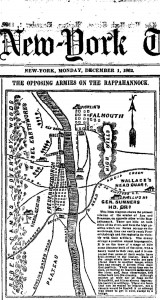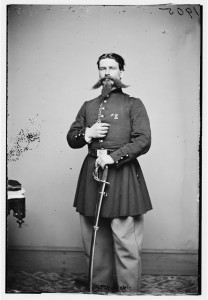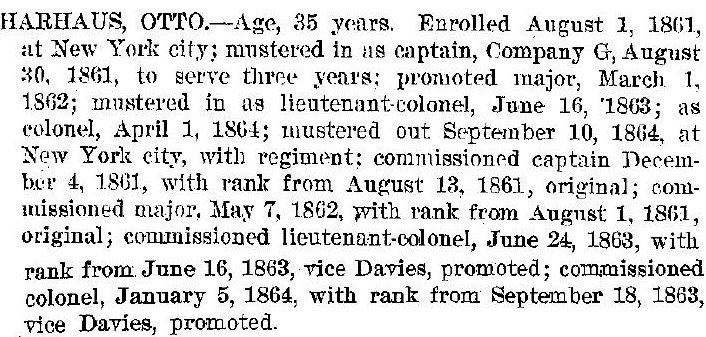150 years ago today there was a lot of information in The New-York Times about the situation near Fredericksburg, Virginia, where the Confederates under General Lee and General Burnside’s Union army faced each other on either side of the Rappahannock River. Here’s a bit about a Union cavalry scouting party’s work. From The New-York Times December 1, 1862:
LETTER FROM BURKE’S STATION.; Operations of the Harris Light Cavalry.
BURKE’S STATION, FIVE MILES FROM THE
POTOMAC, AND ELEVEN FROM FREDERICKSBURGH, Thursday, Nov. 27, 1862.
An important expedition sent out several days since, has just returned here from the country around the mouth of the Rappahannock. On Wednesday, the 19th inst., Gen. BAYARD was ordered to send a portion of his cavalry in a southerly course from Falmouth, for the purpose of clearing out any rebel stragglers, and watching, the movements of the enemy on the other side of the Rappahannock. The force consisted of ten squadrons of the Harris Light Cavalry, led by Major H. HARHAUS, a gallant officer, and about the same number of the First New-Jersey Cavalry, all under command of Col. KARGA. [???] Falmouth on Thursday morning, the 20th, turning off on the crossroad leading to King George Court-house and Port Conway. The men proceeded on their way until night, when they encamped on Col. TAYLOR’s farm. Scouting parties were sent out in the direction of King George and Port Conway. On the next day small squads of men were also sent in various directions. One of these discovered that the rebels had collected on this side of the river 15,000 bushels of wheat and corn, to be forwarded toward Richmond. A long row of teams were discovered on the opposite shore of the Rappahannock, waiting to receive the grain. One hundred and fifty rebel cavalry were also discovered in the rear of Port Royal, opposite to Port Conway, whose mission was to guard this wagon train.
No sooner were the cavalry seen than Col. KARGA determined to shell them. The ten pieces of flying artillery accompanying the expedition were masked in a squadron of the Harris Light Cavalry, which cautiously proceeded in the direction of Port Conway, On reaching the bank of the river the guns were quickly unlimbered, placed in position, sighted, and before the rebels on the opposite side dreamed of our presence two shells were dropped among them; such a skedaddling on a small scale has not been witnessed during the war. The men, some with horses and some without, fled in all directions, to the infinite amusement of our men. The force returning to Col. TAYLOR’s farm at night (Saturday,) and reconnoitering parties were thrown down the Neck as far as Mathias Point. A large amount of whisky, fancy goods, boots, shoes and contraband articles of every description, were found secreted in barns and other places. Maj. HARHAUS of the opinion that notwithstanding the blockade an immense amount of illegal traffic is carried on across the Potomac. One hundred and fifty hogs belonging to the Confederate Government, were also secured. The enemy’s camp fires were visible all along the opposite shore of the Kappahannock, indicating the presence of a very large force. Refugees and contrabands, who had escaped through the rebel lines, informed our officers that the enemy were bringing up which was done [?]. On the afternoon of the 16th, Lieut. [?] all their available force from Richmond, intending to make the fight in the vicinity of Fredericksburgh. The men reached their encampment a short distance from here, much exhausted by their five day’s operations. The Eighth Pennsylvania Cavalry have been sent out to complete the good work commenced.
During the week prior to this expedition, the Harris Light Cavalry were busily employed in finding the fords on the Rappahannock above Fredericksburgh. …
2nd New York Cavalry Regiment was also known as the Harris Light Cavalry after Ira Harris, a U.S. senator from New York.
At the time of this story Col. Sir Percy Wyndham, a rascal from England, was leading a brigade in General George Dashiell Bayard’s division.



